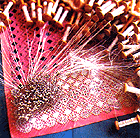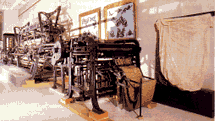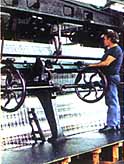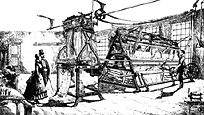|
|
|
|
Lace
- history of lace-making |
|
Traditional
hand-made lace |
|
|
|
Making
lace for the aristocracy State
support |
 3. Traditional lace head-dress |
Traditional
headdress Like the clothes of ordinary people,
these would be heirlooms, handed down from one generation to
the next. |
|
Effects of the French
Revolution |
|
|
|
Making
lace by machine Making lace for the
world |
|
In Calais there are today about 700 looms employing 3,000 workers. The two town's lace factories export about 3/4 of their output to 140 countries. Back to top |
|
|
Inventing a machine to
make lace Industrial
Revolution |
|
|
Industrial
secrets |
|
|
Skills and technology smuggled from England |
|
 6. English "Luddites" broke into factories and smashed up the new machines that put them out of work. Here hungry workers break into a Workhouse to steal bread for their families. |
In 1816 - just after the end of the Napoleonic wars - three skilled workmen from Nottingham, Clark, Webster and Bonnington, thought there might be a better future in France. They smuggled some machinery over to Calais, and were helped to set up a new machine-lace workshops. They escaped from bitter opposition to their new machines back in England. Thousands of poor workers in Nottingham made lace by hand at home, and feared the new machines would deprive them of a living. There were bitter "Luddite" riots in which soldiers guarded the new mills against machine-smashers. In Calais, the emigrant English workmen found people keen to work for them - the port was impoverished after losing its trade during the French wars. The French aristocracy had returned, so a revival in trade for luxury lace looked likely. Back to top |
|
By the 1820's the new Calais lace workshops were flourishing. Protected by heavy tariffs on most imported goods, they didn't need to worry about competition from England. English ex-patriots built rows of terraced houses in the St-Pierre district of Calais with space for their workshops. Some also went to Caudry, near Cambrai, and opened lace factories there. In Calais the industry is still in the hands of family businesses - many with distant English origins. People in Calais still eat Christmas puddings and Welsh rarebit (cheese on toast), customs the English lace-makers brought to the town. Back to top |
|
|
|
In 1835 they perfected a device to make a near-perfect imitation of hand-made lace in any design, including traditional styles like "Chantilly" lace. This was the work of another Englishman, Samuel Fergusson, who adapted the French "Jacquard loom" (used to make tapestries for aristocrats) for making patterned lace - an early example of "numerical control" Back to top |
|
Suffering of the hand lacemakers |
|
|
Lille's statue of "Petit Quinquin" commemorates a lullaby about a poor lacemaker and her hungry child who would not stop crying. On top of the column is Lille composer Alexandre Desrousseaux, who wrote the song in 1858 - when women who made fine lace by hand were being priced out of work by the clever new machines which could match their patterns. The statue is in the park in Square Foch, on rue Nationale (Metro Rihour) |
|
|
Fashions and Free
Trade |
|
|
Today's lace
industry |
|
|
Places
to visit: |
|
Related background
information |
|
|
|
|





